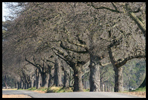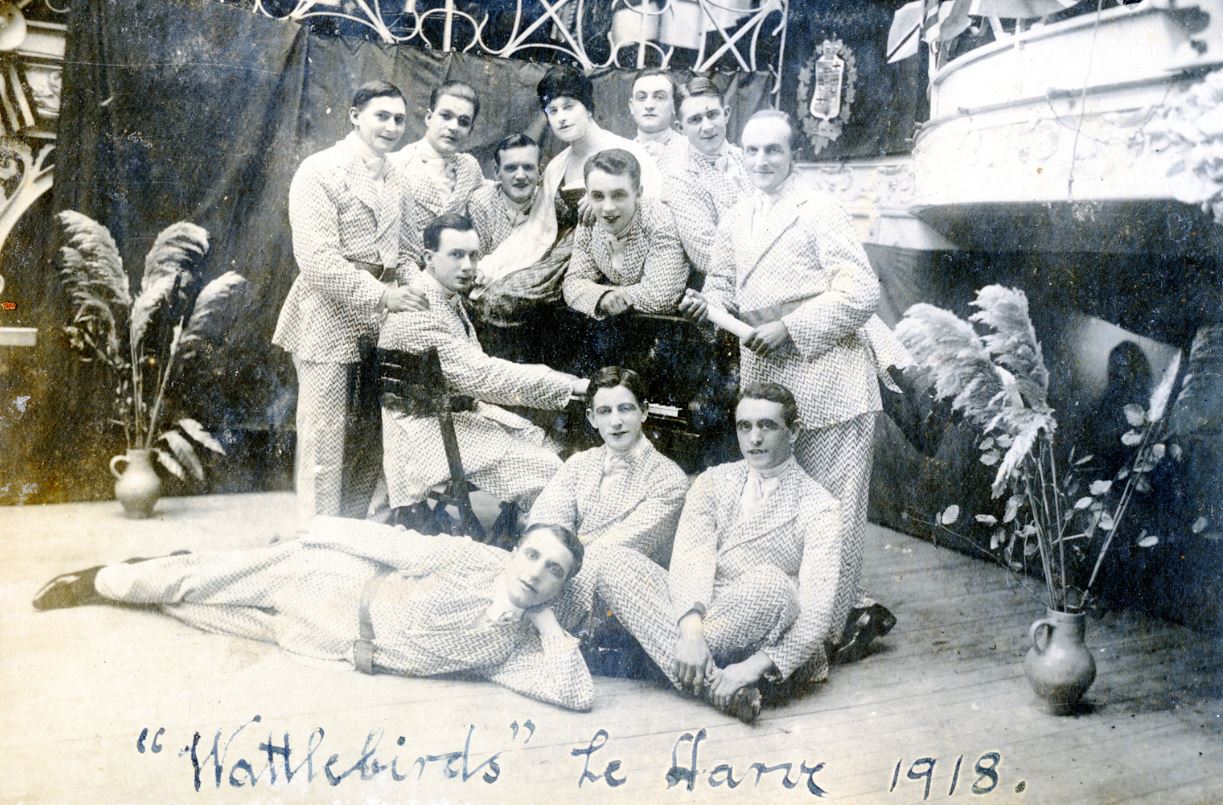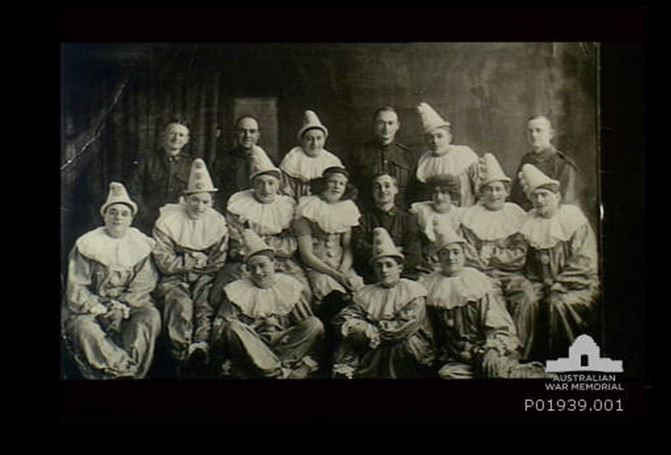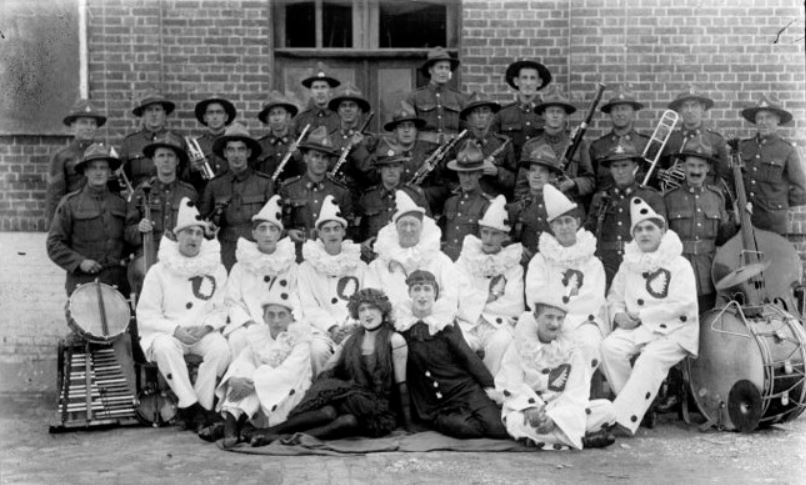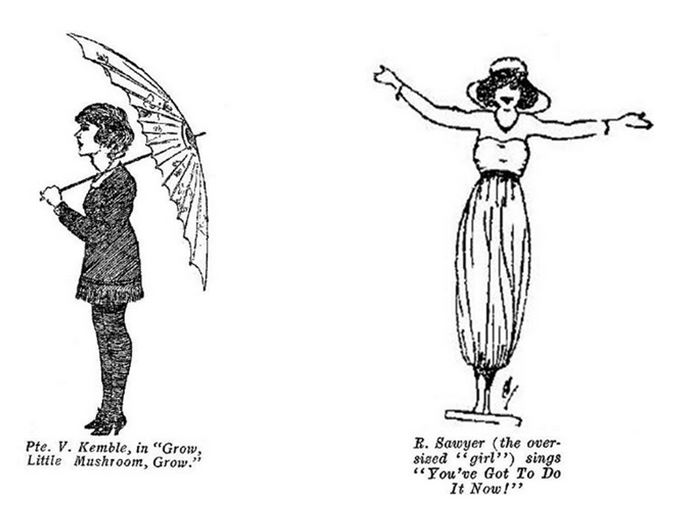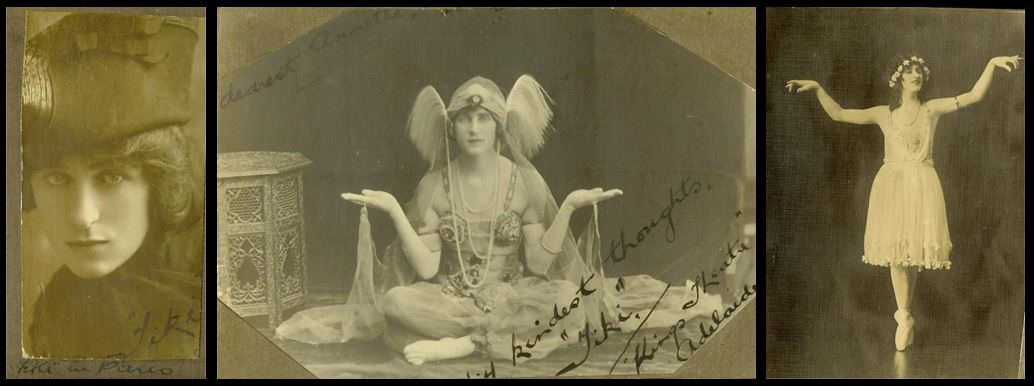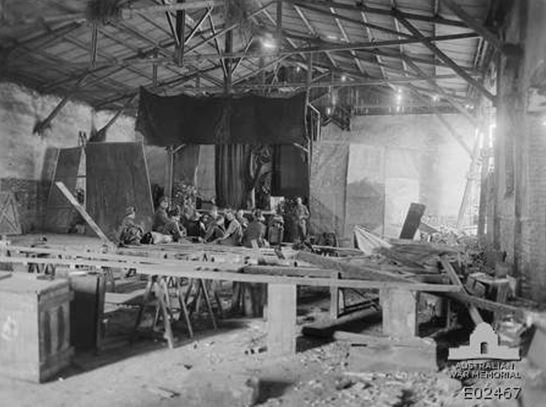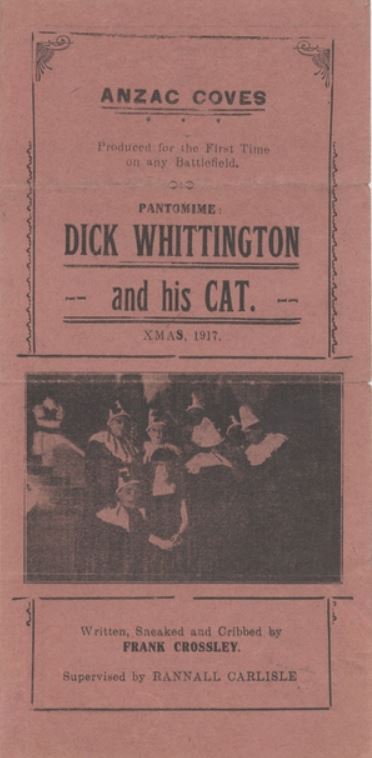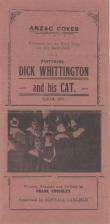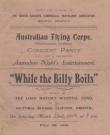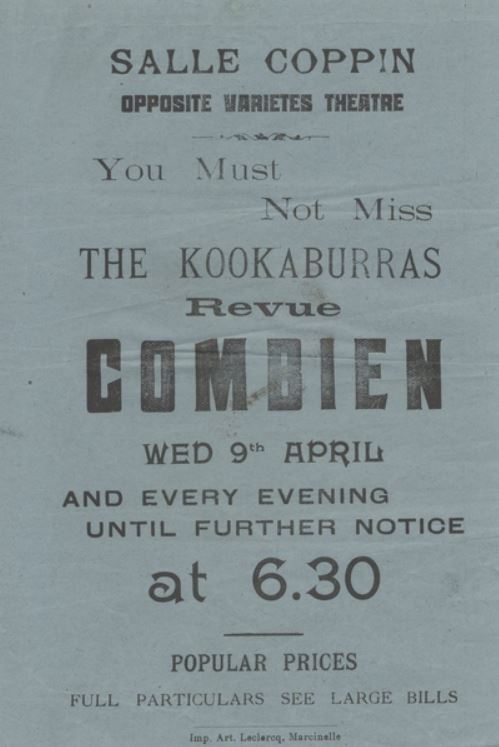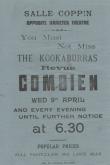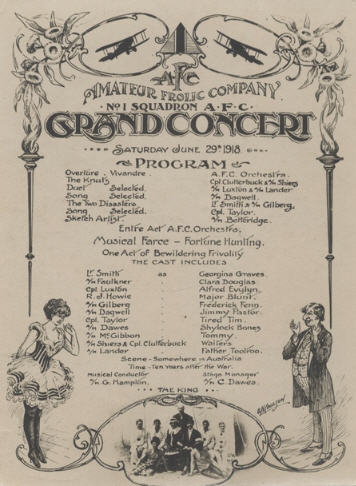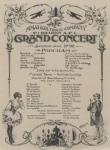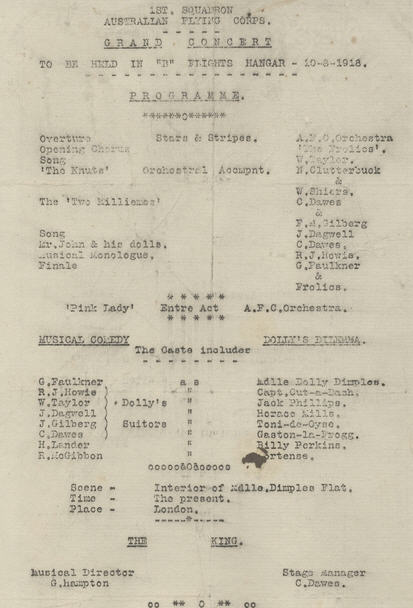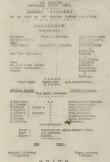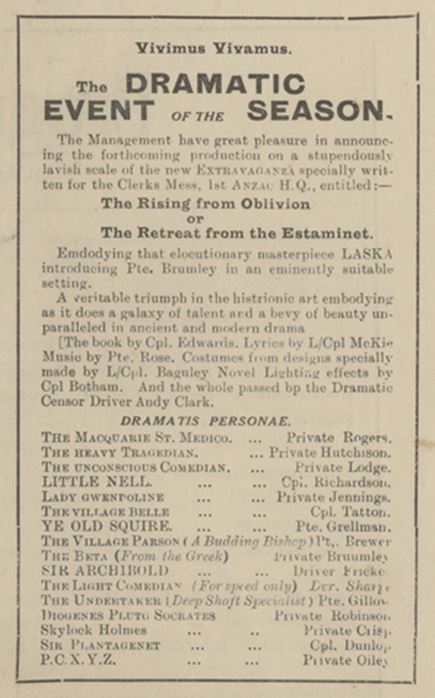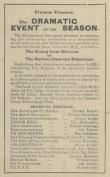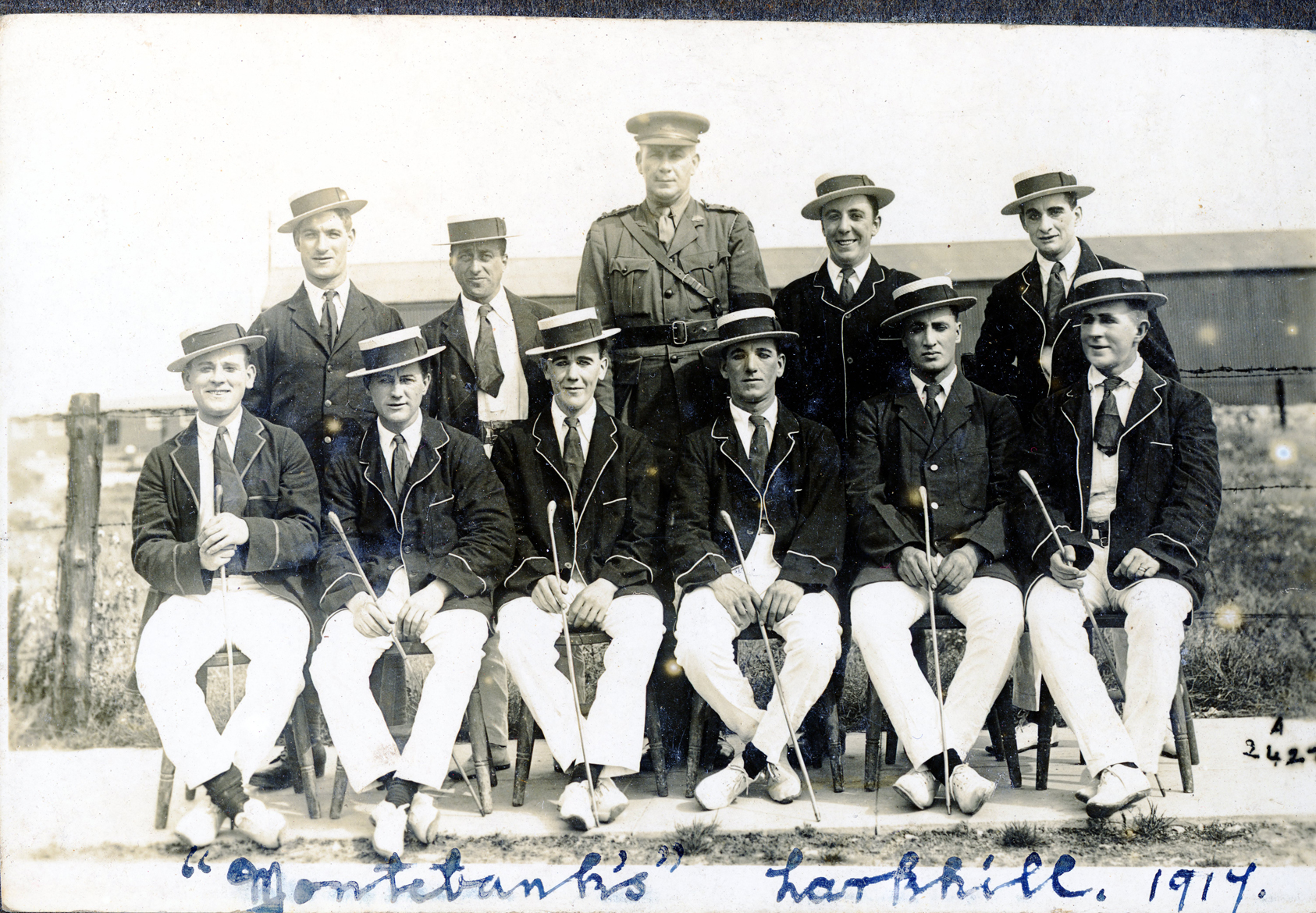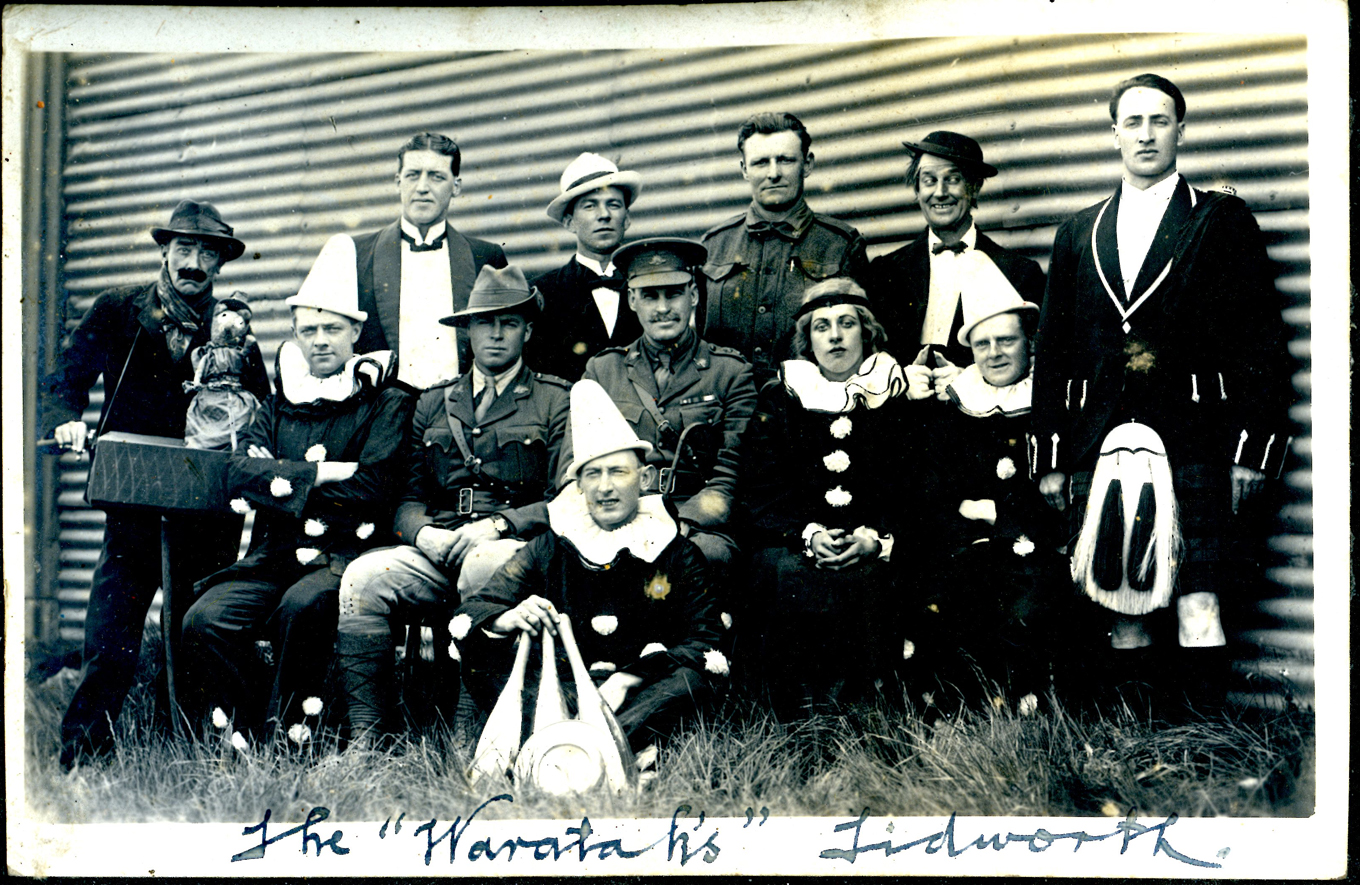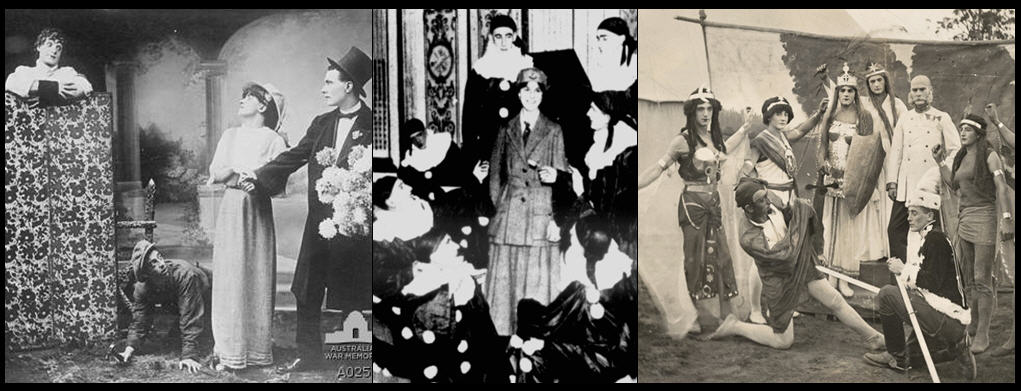AustLit
-
Field theatres, also known as concert parties, were variety-based troupes established by allied military forces during the World War I as a means of boosting moral and relieving monotony. Australian and New Zealand Army Corps (ANZAC) field theatres were organised by various divisions in Europe, North Africa and the United Kingdom between late 1916 and into the immediate post-war period. After being demobilised a number of these soldier troupes turned professional, touring through the Australasian region, the United Kingdom, and the East well into the 1920s and even the early 1930s [see 'Digger Troupes' for more details]
In addition to the divisional field theatres there were other forms of soldier entertainment operating within the ANZAC alliance during World War I. Temporary or one-off shows were often organised for a specific purpose or for a limited time. These included hospital and Christmas concerts, entertainments staged aboard troop carriers bound for the various military zones, and shows staged at the various bases. Concerts of a more 'legitimate' or 'serious' type were also presented by military concert bands. Such entertainments were rarely held close to the line, however.
-
Numerous concert parties and field theatres were established by the allied military forces. In addition to Australia and New Zealand, the English, Scottish, Welsh, Irish, and Canadian forces also had their own entertainment troupes. The idea of entertaining there units and divisions did not occur to the A.I.F. military command until 1916, however, because the commonly-held view was that war would be a short one. Indeed, a common refrain in Great Britain and throughout the Commonwealth following the outbreak of war in August 1914 was that 'the boys would be home by Christmas' (Goemans, p. 13). This sentiment was also expressed in letters and in commentary published throughout the Commonwealth up until 1916.
The reality of a long and protracted war became increasingly evident as the disastrous Gallipoli campaign (April 1915 - January 1916) unfolded, and by the end of 1916 the impact of continuous fighting on the Australian Imperial Forces (A.I.F.) became equally clear to the ANZAC military commanders. With no end in sight to the war, the Australia and New Zealand military commands put in place an edict to resolve the issues of low morale and boredom with their ranks.
The first field theatre troupe to be established within the Australian Imperial Force was the Anzac Coves. Originally financed by the Australian Comforts Funds it comprised soldiers from all A.I.F. Divisions. The troupe’s immediate success led to other concert parties being quickly formed throughout the Australian and New Zealand forces (Djubal, 'Anzac Coves'). W. J. Harvey writes in 1920 that by late 1917 every Division in the A.I.F. had its concert party and that even the Battalions had begun to 'organise troupes which were to be set apart to do nothing more than keep up the spirits of the war-weary men' (p.202).
-
The concerts, allowed the soldiers a break from the constant threat of death or injury and from the mundane existence of life in the trenches. British poet, writer and soldier Siegfreid Sasson once described a show put on near the front lines, writing: 'It wasn't much; a canvas awning; a few footlights....[the performers] were unconscious, it seemed to me, of the intense impact on their audience - that dim brown moonlit mass of men. Row beyond row, I watched those soldiers, listening so quietly, chins propped on hands, to the songs which epitomized their ... longing for the gaiety and sentiment of life' (qtd. in. J. G. Fuller, p.104). Amongst the Australians, the field theatres were seen as a necessity; they provided 'mental recreation' (Aussie. 8 March 1918, p.4.).
-
The field theatres, which tended to adopt similar variety entertainment forms, were essentially a combination of music hall/vaudeville and 'pierrot' costume comedy, a style of entertainment which had become popular in Britain and the Antipodean region before the war (Laugesen, p.84). They provided a wide variety of acts, turns, or performances, with the content including songs (especially the sing-along type), comedy routines, sketches, mini burlesques, revusicals (one-act musical comedies), scenes from well-known plays and films, and specialty acts - ventriloquism, magic, acrobatics etc. Military life also 'featured as an important subject of many skits and songs' (Laugesen, p.84).
Although the Anzac-organised concerts were often attended by other allied units, the shows were created primarily for Australian and New Zealand soldiers. The reverse also occurred, with Australian soldiers sometimes being entertained by other concert parties from other armies and nationalities, including The Thistles (Scotland) and The Yanks (USA).
-
Comedy, and especially ribald, larrikin humour, played a vital role in the shows, especially when it spoke directly to the soldiers in the front line and made fun of their situation. As Clay Djubal writes in 2012: 'That Australian soldiers articulated a resilient, mateship-orientated humour is not surprising given that they had been distanced from their family and pre-war friends and now found themselves fully dependent on the comradeship of those they were fighting alongside. The self-deprecating style of comic exchange that occurred between them is evident in much of the correspondence, published reports and personal insights still available to us today.' While sentimentality also had its place, the main aim of the concert parties and field theatres 'was to send men away happy, laughing, and having felt like they had a good time, some respite from the war.' J. G. Fuller records that while 'the divisional concert parties were held to a standard of propriety, the brigade and battalion troupes much less so' (p.107).
Another feature of the ANZAC concert parties was the female impersonator. The popularity of femininely-attired soldiers meant that most concert parties had at least one performer who specialised in this role. The Smart Set Diggers had five. Among the most famous of the Australian and New Zealand female impersonators were Lindsay Kemble, Charles Holt, Arthur 'Tiki' Carpenter, Ralph Sawyer and Bobbie Roberts.
-
Tiki Carpenter: One of up to five female impersonators in the Smart Set Diggers, Arthur Sydney 'Tiki' Carpenter (below) performed largely as a danseuse. His forte as a dancer also allowed him to specialise in “dainty miss” and flapper-type roles during the company’s sketches and burlesques. Carpenter joined the troupe after the Armistice, having served in France with another concert party, the Green Diamonds, and was still performing as late as 1930.
-
Most of the songs performed in the concert party shows were popular tunes, ranging from comedy numbers, to patriotic and sentimental. In Boredom is the Enemy (2012), Amanda Laugesen writes: 'Songs were often intended to remind soldiers of home and loved ones; along with patriotic tunes, such music may well have incited some soldiers to continue the fight by reminding them of what they were fighting for and what they would be returning to if and when they won the war.' She further records some of 8th Battalion entertainer Private Ernest Nicholls' memoirs, and in particular the 'The Laughing Song.' The words in this ditty refer to a soldier 'who laughs at anything and everything, including the prospect of death and the gruesome surroundings of combat' (p.85).
-
The hardships encountered by the Anzac concert parties may not have been of the type experienced by soldiers fighting on the front line but they were certainly trying. Most, if not all, parties travelled close to the front and were forced to set up their shows in all manner of places - sometimes in bombed out buildings, and often in the open-air, using whatever materials and equipment was at hand. A Coo-ees' concert program from 1918 highlights the conditions under which they regularly performed:
Sometimes in a shell-torn hall in some shattered village, sometimes in an old barn, and always with the evidence of war around, the work has gone on and always with the same cheerfulness and desire to do all that was possible for the man whose few hours of respite has been so-welled earned.
-
Field theatres also performed for civilian audiences on occasion, with fund-raising being the most common objective. The Anzac Coves, for example, played before the British Royal Family in February 1918. The Perham Stars, reportedly staged a fund-raising variety show in London around the same time for the Red Cross, while the A.F.C. Concert Party staged a production of While the Billy Boils in March 1919 to raise money for the Lord Mayor of Bristol's Hospital Fund.
Following the armistice that came into effect on 11 November 1918, the A.I.F. returned to Australia in stages, with some elements remaining to perform reconstruction and military occupation duties in Europe. As the various divisions and corps gradually disbanded the entertainment units also contracted. Performers were subsequently re-assigned to different concert parties across different divisions, with the majority of troupes performing in England, France and Belgium.
-
-
-
Amateur Frolics Company: No 1 Squadron Australian Flying Corps Concert Party.
The Anzac Coves: 1 Australian Headquarters Pierrot Troupe.
The Australian Dandies: Australian General Base Depot Concert Party, Le Havre, France.
Australian Flying Corps Concert Party: Australian Flying Corps (based at Minchinhampton Aerodrome in 1919)
The Blue Dandies: 4 Australian Infantry Brigade.
The Blue Diamonds: 7th Australian Infantry Brigade Concert Party.
The Coo-ees: Australian Divisional Concert Party.
The Empties (M.Ts): Mechanical Transport, 4 Division Ammunition Sub Park (France).
Field Artillery Pirates: Possibly a one-off, non-divisionally-organised concert performed by artillery and infantry soldiers on 21 October 1915.
The Flying Kangaroos: No 7 Squadron, Australian Flying Corps. Possibly based at Leighterton Aerodrome, ca. 1918.
The Green Diamonds: Fifth Brigade Australian Imperial Force Concert Party.
The Kangaroo Koncert Kompany: A.I.F. Signals Corps.
The Kangaroos [1]: No 3 Command Depot (Salisbury, England).
The Kangaroos [2]: Australian Graves Detachment, France.
The Kookaburras [1]: Fifth Australian Divisional Concert Party.
The Kookaburras [2]: No 2 Squadron Australian Flying Corps Concert Party. Also known as The Flying Kookaburras.
The Kookaburras [3]: No 14 Australian General Hospital Concert Party.
The Montebanks: Possibly based at the Lark Hill training camp, Salisbury Plain, England.
The Nightbirds: 8th Field Ambulance Concert Party. Formed in Egypt in 1917 and later active in France and Belgium.
NZ Digger Pierrots: Formed on the Western Front in 1917 in order to entertain New Zealand soldiers. Toured after the war as the Vice Regals, then the Famous Diggers.
The Perham Stars (aka The Aussies): 'A' Training Camp, Perham Downs, England (8 Battalion).
The Serenaders: 1st Division Artillery Concert Party.
The Sentimental Blokes: 1 Australian Divisional Concert Party.
The Shrapnels:
The Smart Set Diggers: Fouth Divisional Concert Party.
The Sundowners:
Tropical Troubadours: Australian Naval and Military Expeditionary Force, Raboul (Papua New Guinea), 1919.
The Wattle Birds: A 12-member troupe known to have been performing in Europe around 1918, with a female impersonator.
The Waratahs: Possibly based at the Tidworth training camp, Salisbury Plain, England.
The Wombats: 10 Australian Field Artillery Brigade Concert Party.
-
"Laughing at the Front" features interviews with Professor Richard Fotheringham, Dr Clay Djubal, Professor Graham Seal, and Dr Lisa Trahair. The program was broadcast on ABC Radio's Hindsight on 24 April 2011. The interviewer and producer is Jennifer Bowen. The presenter is Lorena Allam.
Access the ABC HIndsight website and audio recording here >> Laughing at the Front
-
- 'Anzac Coves.' Australian Variety Theatre Archive. (sighted 16 Jan. 2014)
- Collins, L. J. Theatre at War. New York : St. Martin's Press, 1998.
- 'Coo-ees.' Australian Variety Theatre Archive. (sighted 16 Jan. 2014)
- Cullen, Sue. "Australian Theatre During World War One." Australasian Drama Studies 17 (Oct. 1990),pp.157-181.
- Djubal, Clay. "'For the Duration': Australian One Act Musical Comedies and the Fashioning of an Imagined National Identity between 1914 and 1918." Mix Bag: Early Australian Variety Theatre and Popular Culture Entertainment Series No 1 (2012). (sighted 16 Jan. 2014).
- Djubal, Clay. 'What Oh Tonight" The Methodology Factor and Pre-1930s Australian Variety Theatre.' Ph D Thesis, The University of Queensland, 2005.
- Fotheringhamn, Richard. 'Laughing it Off: Australian Stage Comedy after World War 1.' History Australia 7.1 (2010), pp.03.1-03.20.
- Fuller, J. G. Troop Morale and Popular Culture in the British and Dominion Armies, 1914-1918. Oxford: Clarendon Press, 1990.
- Goemans, H. E. War and Punishment: The Causes of War Termination and the First World War. Princeton: Princeton University Press, 2000.
- 'Guide to the Concert and Theatre Programs Collection, First World War, 1914-1918. Collection number: Souvenirs 2.' Australian War Memorial. Research Centre Published and Digitised Collections, Canberra, ACT.
- Harris, Phillip L, ed. Aussie: The Australian Soldiers' Magazine. 'In the Field' : Australian Imperial Forces (A.I.F. Printing Section), 1918-1919.
- 'Kookaburras.' Australian Variety Theatre Archive (sighted 16 Jan. 2014)
- Harvey, W J. The Red and White Diamond: Authorised History of the Twenty-Fourth Battalion A.I.F. Melbourne. A. McCubbin (for the 24th Battalion Association), ca. 1920.
- Laugesen, Amanda. Boredom is the Enemy. Farnham, Surrey: Ashgate, 2012, pp.79-104.
- 'Laughing at the Front.' Hindsight. ABC Radio National, broadcast 24 April 2011.
- Morrow, Edgar. (1934), Iron in the Fire. Sydney: Angus and Robertson, 1934.
- 'Smart Set Diggers.' Australian Variety Theatre Archive. (sighted 16 Jan. 2014)
You might be interested in...

